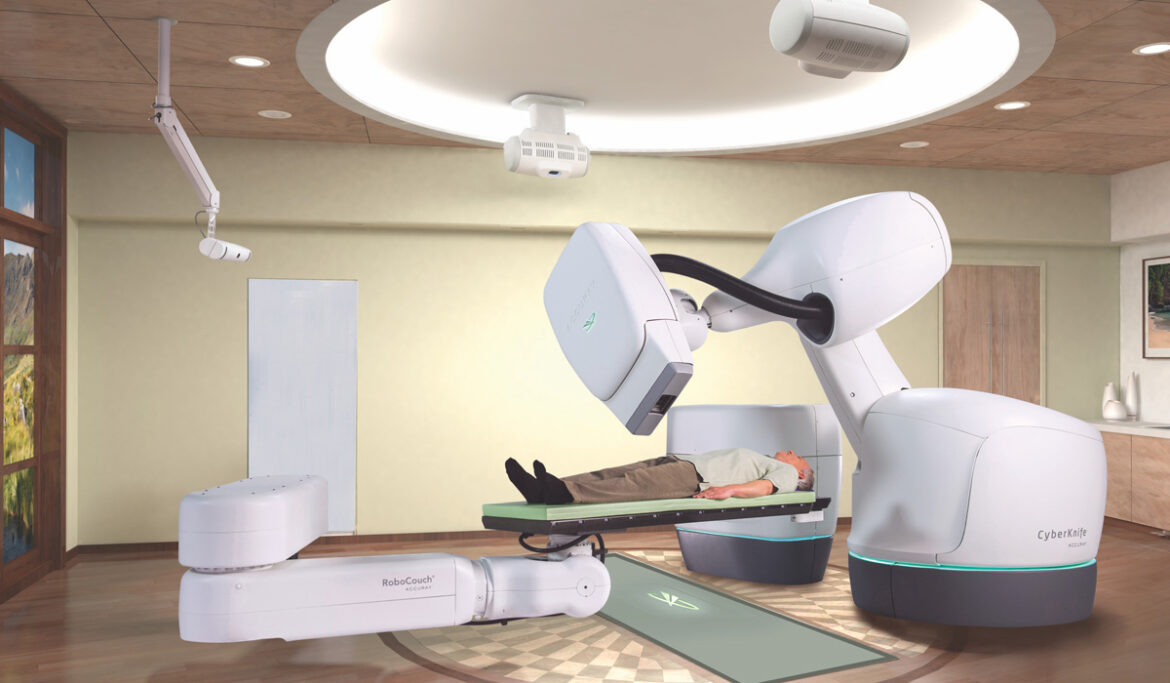What is CyberKnife?
The first robotic radiosurgery system in the world that is specifically designed to treat tumors located at different parts of the body such as prostate, brain, pancreas, liver and lungs is known as Cyberknife robotic radiosurgery system.
This treatment is non-invasive alternative to surgery where high doses of radiation are delivered with extreme accuracy. These high dose radiation beams can be given from any angle by precisely concentrating on the tumor while causing minimum damage to the nearby healthy tissue and significant structures such as optic nerve or spinal cord.
Types of Conditions Treated by the CyberKnife Surgery
Cyberknife radiation surgery is used for treating both cancerous and non-cancerous tumors. Following are some of the conditions treated by Cyberknife radiation surgery –
- Orbital inflammations, metastatic orbital tumors and orbital lymphomas
- Cancers involving the brain
- Metastatic liver cancers
- Trigeminal neuralgia
- Benign brain tumors
- Lung cancers
- Malformations of blood vessels inside the brain
- Pancreatic cancers
- Benign brain tumors
- Cancers involving the spine
Benefits of Cyberknife Surgery
Cyberknife treatment offers many benefits as compared to other treatments. This treatment is ideal for those patients who are unable to go through traditional surgery. Some of its benefits are –
- The tumors can be further treated even if they have received the maximum allowed dosage of radiation
- No anesthesia
- Completely frameless
- There is minimal radiation exposure to healthy organs and tissues
- No pain
- No hospitalization
- No bleeding
- No incisions
- Immediate return to the normal daily routine
Cyberknife Treatment Procedures
The working of a Cyberknife treatment is primarily performed in two ways. The insertion of lightweight delivery equipment is made on a multi-jointed robotic arm in the first approach. This is done for reaching the tumor in any body part. The image guidance system is used in the second approach that helps the Cyberknife system to allocate and track the tumor.
Robotics and image guidance is used for maintaining an accurate precision and this treatment is specifically useful for those tumors that are near to significant structures. Lesions and tumors can be treated through numerous angles without involving any treatment interruption or clinician intervention.
When is Cyberknife a Suitable Treatment Option?
Radiation therapy, surgery or chemotherapy are some of the traditional therapies that are used in combination with Cyberknife stereotactic radiosurgery. Following are the circumstances that require Cyberknife system –
- When a patient does not want to go through a traditional surgery
- When a patient is unable to undergo a surgery
- Recurrence of a tumor close to a significant structure like the spine, that previously received the maximum dose of radiation
- When surgery is not able to remove the entire diseased tissue
- When the tumor is located near a significant structure like optic nerves were performing a traditional surgery can increase the risk of damage to these structures
- When a surgical procedure is difficult to perform
CyberKnife versus Radiation Therapy
Radiation therapy has been used for a long time for treating malignant and benign tumors. CyberKnife is altogether a new and latest concept that is very different from other treatment methods. The major benefit of Cyberknife as compared to other treatment options is its accurate precision that helps in maximizing the quantity of radiation. This radiation reaches the abnormal growth or tumor that minimizes the damage to healthy organs and tissues. Cyberknife robotic-assisted radiosurgery is new hope for those patients who are suffering from localized prostate cancer. This system is also beneficial for treating prostate cancer that has come back again after previous treatment or radical prostatectomy.
Radiosurgery does not involve the removal of the tumor and uses high radiation doses for destroying the tumor cells. A linear accelerator produces numerous radiation beams that are directed at the abnormal growth inside the body. Modified linear accelerators and the Gamma Knife are considered the most common radiosurgery systems.
Frequently Asked Questions about Cyberknife
What are the condition that Cyberknife can treat?
Cyberknife effectively treats malignant tumors and other benign tumors in any location of the human body. There are also uses recorded for treating liver, pancreas, prostate, and neck cancers.
How does cyberknife system work?
There are several methods for cyberknife surgery but two main features since its inception have been the robotic mounting and image guidance system, unlike other stereotactic systems. For soft tissue of tumors, the surgeons use a method called “fiducial” tracking.
How is the cyberknife system different from other radiation delivery systems?
In other stereotactic systems, the Gamma Knife is used as the main device for the radiosurgery system. But in cyberknife, the robotic mounting is effective. Cyberknife is frameless. In a frame-based system, for patients with fragile heads like that of children, a frameless system can re-treat the person without the hassle of a frame-based one. Cyberknife also allows a larger dose of radiation to flow than of single treatment.
